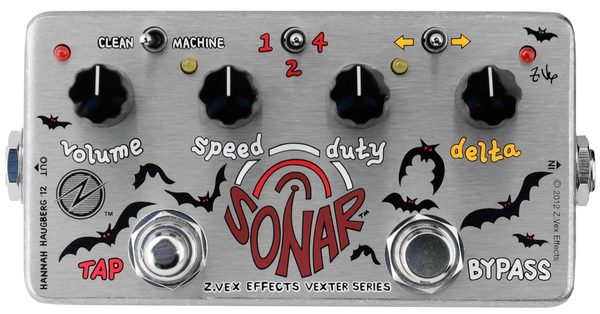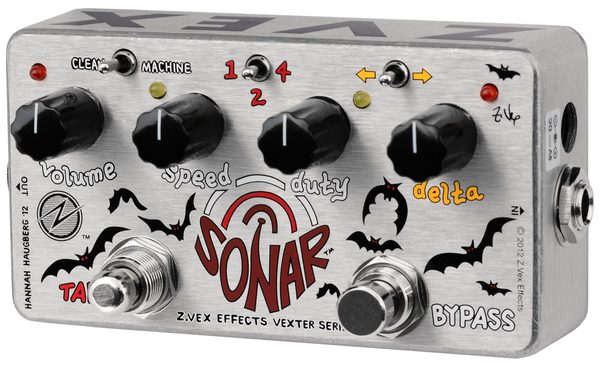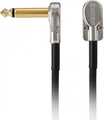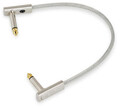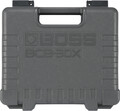Zvex Vexter Sonar
Tremolo Pedal
EUR 259.00
Incl. VAT, free shipping in Germany
| Product # | 174474 |
| Brand | Zvex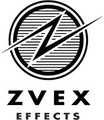 |
| Category | Tremolo Pedals | Brand Category | Zvex - Tremolo Pedals |
| Series | Zvex Vexter |
| Release date | July 2014 |
| Availability |  Will be ordered for you as quick as possible Will be ordered for you as quick as possible |
Description
Yes, the Sonar is a "tremolo" pedal, but this one's different. This unit has the ability to chop up any signal you send into or out of it. Unlike most other tremolos, it can cut down your high gain signal to silence. It can also sound gorgeously transparent like a traditional tremolo. It does other fun stuff like increase or decrease tempo, duty cycle (amount of time the trem is on in a given cycle), or both simultaneously on the fly. It also has tap tempo and a slew of advanced features (attack, release, and depth controls). Lastly, and
perhaps most importantly, it has a famed Zvex "Machine" circuit built right into the box.
Operations:
Plug your guitar into the input jack and your amp into the output jack (or you might mix it with other pedals). It can be anywhere in the chain, but if you are using it in "Machine" mode you might want to put it before other dirt boxes to hear it cut through those effects.
Battery change and power supply:
The Sonar draws about 10mA and can be powered with a 9V battery (remove the four screws on the bottom for replacement) or any standard filtered/regulated musical 9VDC power supply with a Boss-style connector (negative-tip barrel connector). We recommend using an alkaline 9V battery.
Summary of controls:
The knobs:
- 1. Volume: Park this all the way clockwise for slightly over unity gain. If you need more gain (on either "clean" or "machine" modes), a trimmer is inside the pedal that can be pushed harder clockwise. This will break-up the "clean" signal though.
- 2. Speed: Manual control of tempo
- 2a. Attack: Controls how quickly audio reaches peak volume of tremolo
- 3. Duty: Controls duration of peak audio, the "on" portion of tremolo
- 3a. Release: Controls how quickly audio ramps down from peak
- 4. Delta: Controls the rate of change when unit is in "Arrow Up/Down Mode"
- 4a. Depth: Controls minimum volume of quiet portion of tremolo
The switches:
- 1. Bypass: Effect On/Off
- 2. Tap Tempo: Calculates tempo by taking the last two user taps. Always overrides a manually set tempo. The pedal will allow tempos as slow as 4 seconds per cycle.
- 2A. This switch also functions as a "shift key" to access Hidden Wave Shaping functions
- 3. Clean / Machine mini toggle switch: "Clean" is a rela- tively clean sound based on our Super Hard On boost. "Machine" is our gnarly cross-over distortion circuit.
- 4. Tap Tempo mini toggle switch - Allows user to set tempo to 2x or 4x original tap rate.
- 5. Arrow Up /Down - Controls the up or down direction of auto parameter change, also selects which parameters are being changed.
Delta knob and arrow toggle:
The delta and arrow toggle allow users to change the speed and duty parameters on the fly in 3 "modes": tempo, duty cycle, or both simultaneously. The delta knob only does stuff if the arrow toggle is in the right or left position. Any time you change the arrow toggle to the right or left position, one or both of the yellow LEDs next to the speed and duty knobs will light up. Whenever a yellow LED is lit next to these knobs, it means that the delta knob has control over the changing of that parameter (turning a knob with a solid yellow LED next to it won't do anything). For example, let's say you have the delta knob parked fully counterclockwise (slowest acceleration). Flip the arrow toggle to the right. The yellow LED next to the speed knob lights up. The tempo is now accelerating at a slow rate from whatever you had it set at. If you flip the arrow toggle the opposite direction in one motion, the tempo will decrease at that same slow rate. Moving the delta knob clockwise increases this rate. If you'd rather change the duty cycle (instead of the tempo), flip the arrow toggle back to the middle, then flip it to one of the sides within a second. Now the yellow LED next to the duty knob will be lit up. The delta knob is now controlling how fast the silence in a trem cycle is shrinking or growing. In the right arrow position, the silence grows, and in the left arrow position it shrinks. You can also change both duty cycle and tempo in this fashion by changing to the third "mode" where both yellow LEDs are lit up. This probably sounds confusing, but it's pretty intuitive once you learn it and can produce some very interesting effects.
Hidden features:
The hidden features described here give you the ability to shape the tremolo with lots of variations outside of a square wave. These controls include attack, release, and depth. The duty parameter is also intimately linked to this wave shaping. In short, the attack parameter controls how quickly the wave reaches its peak, and the release parameter controls how quickly the wave reaches its low point. The depth parameter allows you to increase the "bottom" of the wave from levels higher than silence.
To access these parameters, you need to hold down the tap
button for one second. Keep holding the tap button. The yellow LEDs should start slowly flashing. The speed knob is now attack, the duty knob is release, and the delta knob is now depth. The original parameters will not change unless you move the knobs. For example, grab the attack knob (which, of course, actually says "speed" next to it... but you are still holding the tap button that magically makes it the "attack" parameter) and move it clockwise. The yellow LED will blink more often the farther you rotate the knob clockwise. Do the same with the release knob (which says "duty" next to it). Releasing the tap button will save these settings, even on power down. After you release the tap button, you are back to your normal controls. Again, a normal setting (such as duty) will change when you move the knobs now that you are back to the standard controls.
perhaps most importantly, it has a famed Zvex "Machine" circuit built right into the box.
Operations:
Plug your guitar into the input jack and your amp into the output jack (or you might mix it with other pedals). It can be anywhere in the chain, but if you are using it in "Machine" mode you might want to put it before other dirt boxes to hear it cut through those effects.
Battery change and power supply:
The Sonar draws about 10mA and can be powered with a 9V battery (remove the four screws on the bottom for replacement) or any standard filtered/regulated musical 9VDC power supply with a Boss-style connector (negative-tip barrel connector). We recommend using an alkaline 9V battery.
Summary of controls:
The knobs:
- 1. Volume: Park this all the way clockwise for slightly over unity gain. If you need more gain (on either "clean" or "machine" modes), a trimmer is inside the pedal that can be pushed harder clockwise. This will break-up the "clean" signal though.
- 2. Speed: Manual control of tempo
- 2a. Attack: Controls how quickly audio reaches peak volume of tremolo
- 3. Duty: Controls duration of peak audio, the "on" portion of tremolo
- 3a. Release: Controls how quickly audio ramps down from peak
- 4. Delta: Controls the rate of change when unit is in "Arrow Up/Down Mode"
- 4a. Depth: Controls minimum volume of quiet portion of tremolo
The switches:
- 1. Bypass: Effect On/Off
- 2. Tap Tempo: Calculates tempo by taking the last two user taps. Always overrides a manually set tempo. The pedal will allow tempos as slow as 4 seconds per cycle.
- 2A. This switch also functions as a "shift key" to access Hidden Wave Shaping functions
- 3. Clean / Machine mini toggle switch: "Clean" is a rela- tively clean sound based on our Super Hard On boost. "Machine" is our gnarly cross-over distortion circuit.
- 4. Tap Tempo mini toggle switch - Allows user to set tempo to 2x or 4x original tap rate.
- 5. Arrow Up /Down - Controls the up or down direction of auto parameter change, also selects which parameters are being changed.
Delta knob and arrow toggle:
The delta and arrow toggle allow users to change the speed and duty parameters on the fly in 3 "modes": tempo, duty cycle, or both simultaneously. The delta knob only does stuff if the arrow toggle is in the right or left position. Any time you change the arrow toggle to the right or left position, one or both of the yellow LEDs next to the speed and duty knobs will light up. Whenever a yellow LED is lit next to these knobs, it means that the delta knob has control over the changing of that parameter (turning a knob with a solid yellow LED next to it won't do anything). For example, let's say you have the delta knob parked fully counterclockwise (slowest acceleration). Flip the arrow toggle to the right. The yellow LED next to the speed knob lights up. The tempo is now accelerating at a slow rate from whatever you had it set at. If you flip the arrow toggle the opposite direction in one motion, the tempo will decrease at that same slow rate. Moving the delta knob clockwise increases this rate. If you'd rather change the duty cycle (instead of the tempo), flip the arrow toggle back to the middle, then flip it to one of the sides within a second. Now the yellow LED next to the duty knob will be lit up. The delta knob is now controlling how fast the silence in a trem cycle is shrinking or growing. In the right arrow position, the silence grows, and in the left arrow position it shrinks. You can also change both duty cycle and tempo in this fashion by changing to the third "mode" where both yellow LEDs are lit up. This probably sounds confusing, but it's pretty intuitive once you learn it and can produce some very interesting effects.
Hidden features:
The hidden features described here give you the ability to shape the tremolo with lots of variations outside of a square wave. These controls include attack, release, and depth. The duty parameter is also intimately linked to this wave shaping. In short, the attack parameter controls how quickly the wave reaches its peak, and the release parameter controls how quickly the wave reaches its low point. The depth parameter allows you to increase the "bottom" of the wave from levels higher than silence.
To access these parameters, you need to hold down the tap
button for one second. Keep holding the tap button. The yellow LEDs should start slowly flashing. The speed knob is now attack, the duty knob is release, and the delta knob is now depth. The original parameters will not change unless you move the knobs. For example, grab the attack knob (which, of course, actually says "speed" next to it... but you are still holding the tap button that magically makes it the "attack" parameter) and move it clockwise. The yellow LED will blink more often the farther you rotate the knob clockwise. Do the same with the release knob (which says "duty" next to it). Releasing the tap button will save these settings, even on power down. After you release the tap button, you are back to your normal controls. Again, a normal setting (such as duty) will change when you move the knobs now that you are back to the standard controls.
Attributes
Key attributes
| ||||||||||||||
Tremolo Pedal attributes
| ||||||||||||||
Product Details
| ||||||||||||||
Dimension
|
Properties
- Effect Type: Tremolo/Vibrato
- Technology: Analog
- Mono / Stereo: Mono In, Mono Out
- Controls: Volume, Speed, Duty, Delta, Attack, Depth, Release
- Modes: 7 Modes
- Switches: Clean/Machine, 1/2/4, Direction
- Bypass Mode: True bypass
- Power supply: 9 VDC, Center negative
- Power Consumption: n. a.
- Battery powered: Battery Powered
- Battery Type: 9 V Block
- Housing size: Standard
- Dimensions (WxHxD): 110 x 32 x 60 mm
- Also suitable for bass: yes
- Country of Origin: USA
- integrated Machine Fuzz
- Technology: Analog
- Mono / Stereo: Mono In, Mono Out
- Controls: Volume, Speed, Duty, Delta, Attack, Depth, Release
- Modes: 7 Modes
- Switches: Clean/Machine, 1/2/4, Direction
- Bypass Mode: True bypass
- Power supply: 9 VDC, Center negative
- Power Consumption: n. a.
- Battery powered: Battery Powered
- Battery Type: 9 V Block
- Housing size: Standard
- Dimensions (WxHxD): 110 x 32 x 60 mm
- Also suitable for bass: yes
- Country of Origin: USA
- integrated Machine Fuzz
Brand
Report incorrect data about this product
Recommended accessories
BlackLine DC0103AA (15cm)
EUR 7.79



 (5)
(5)